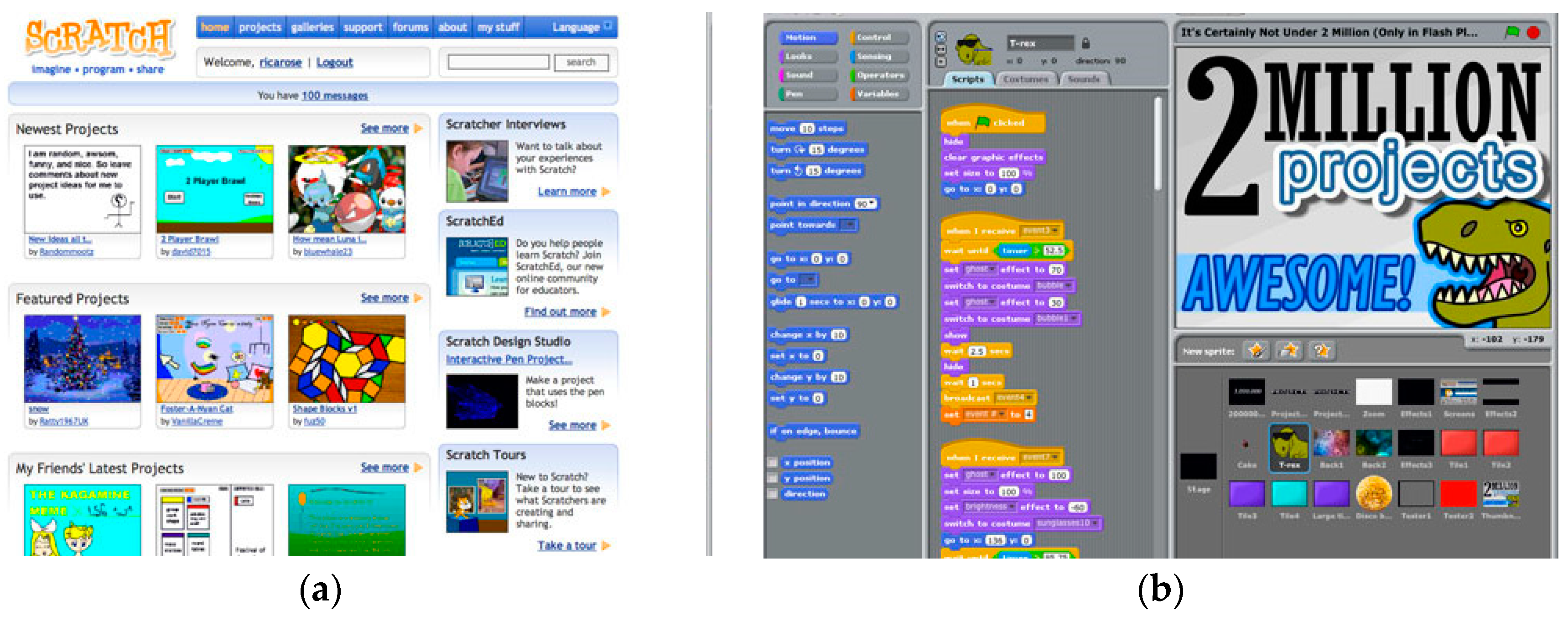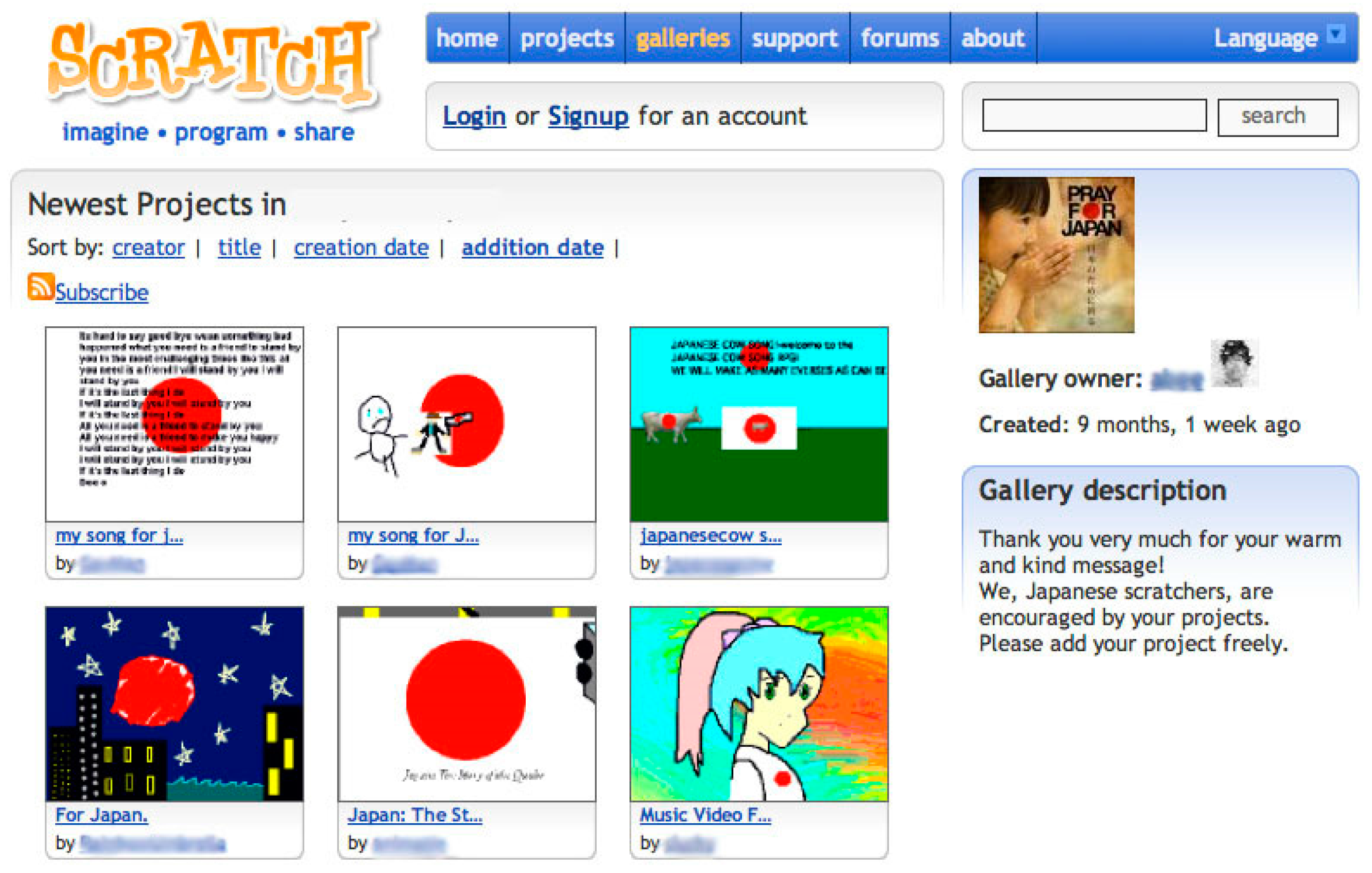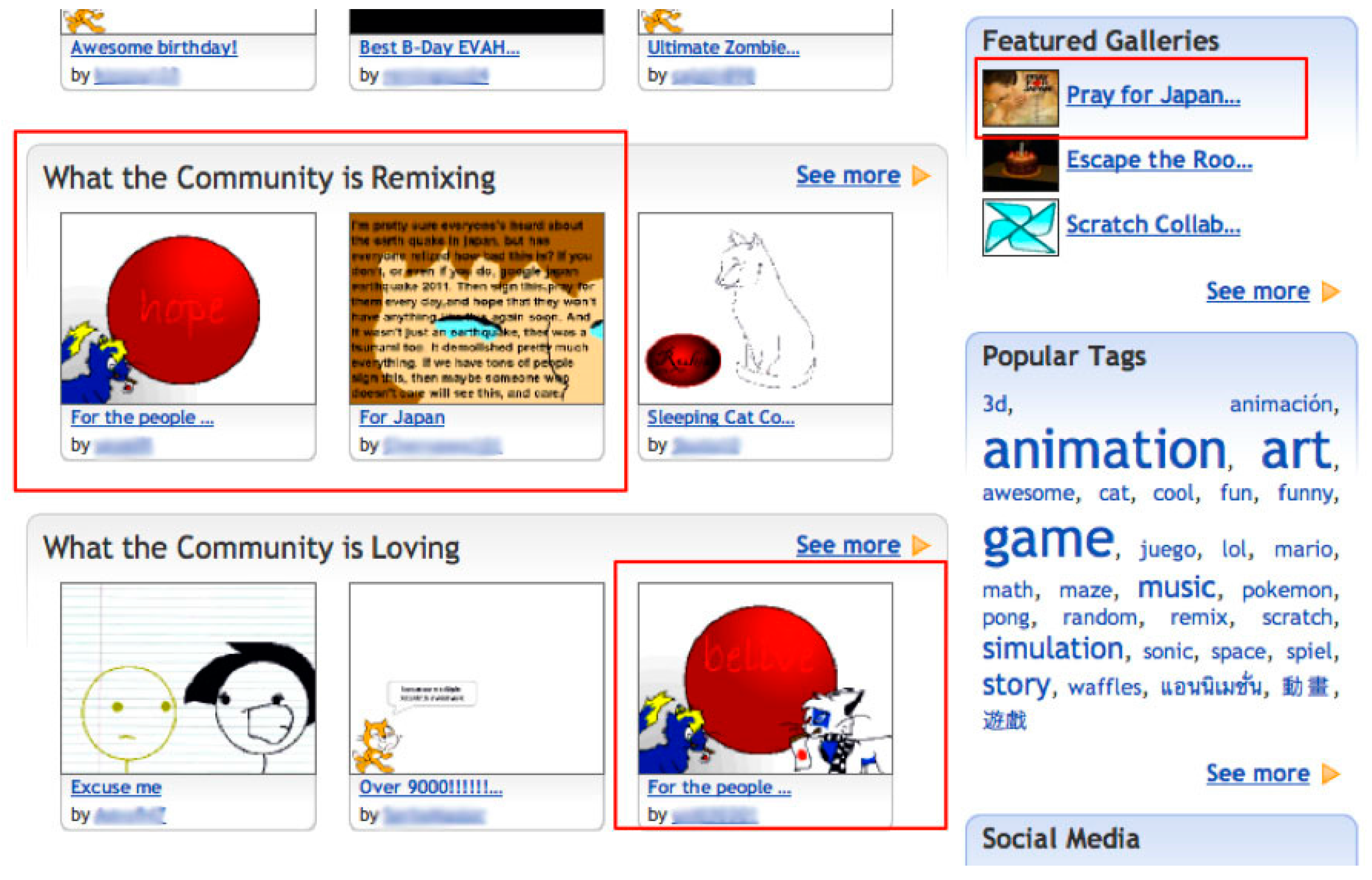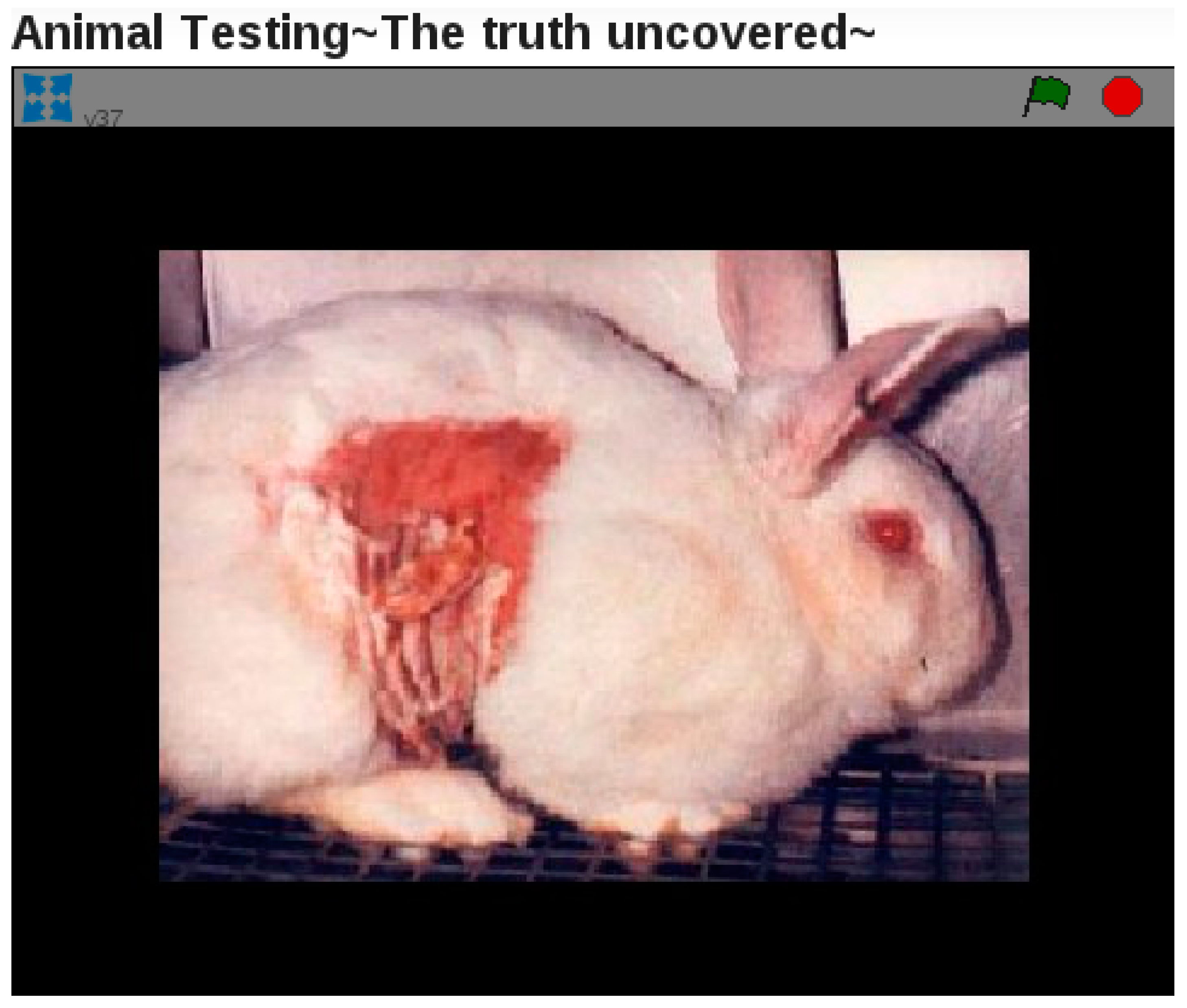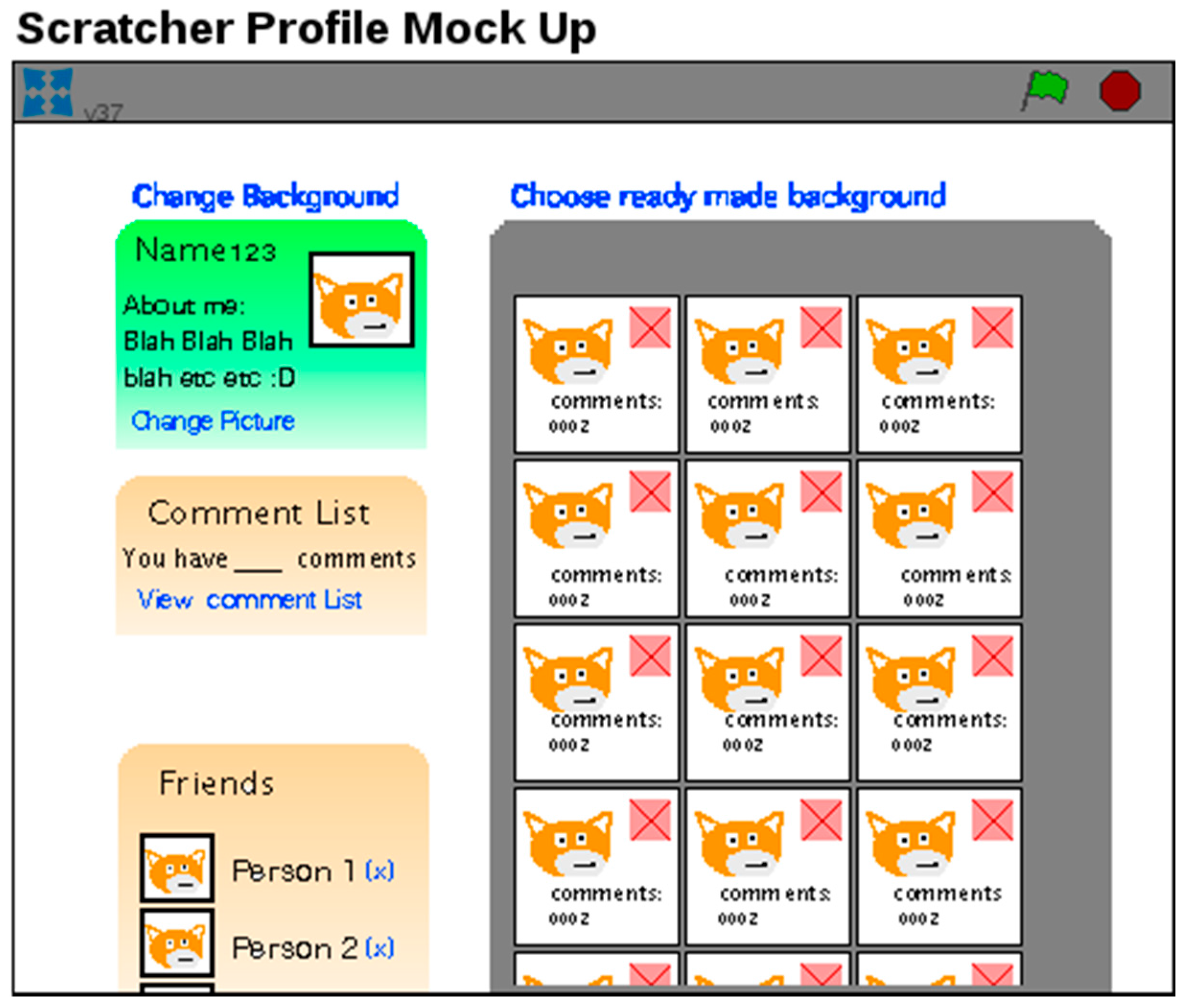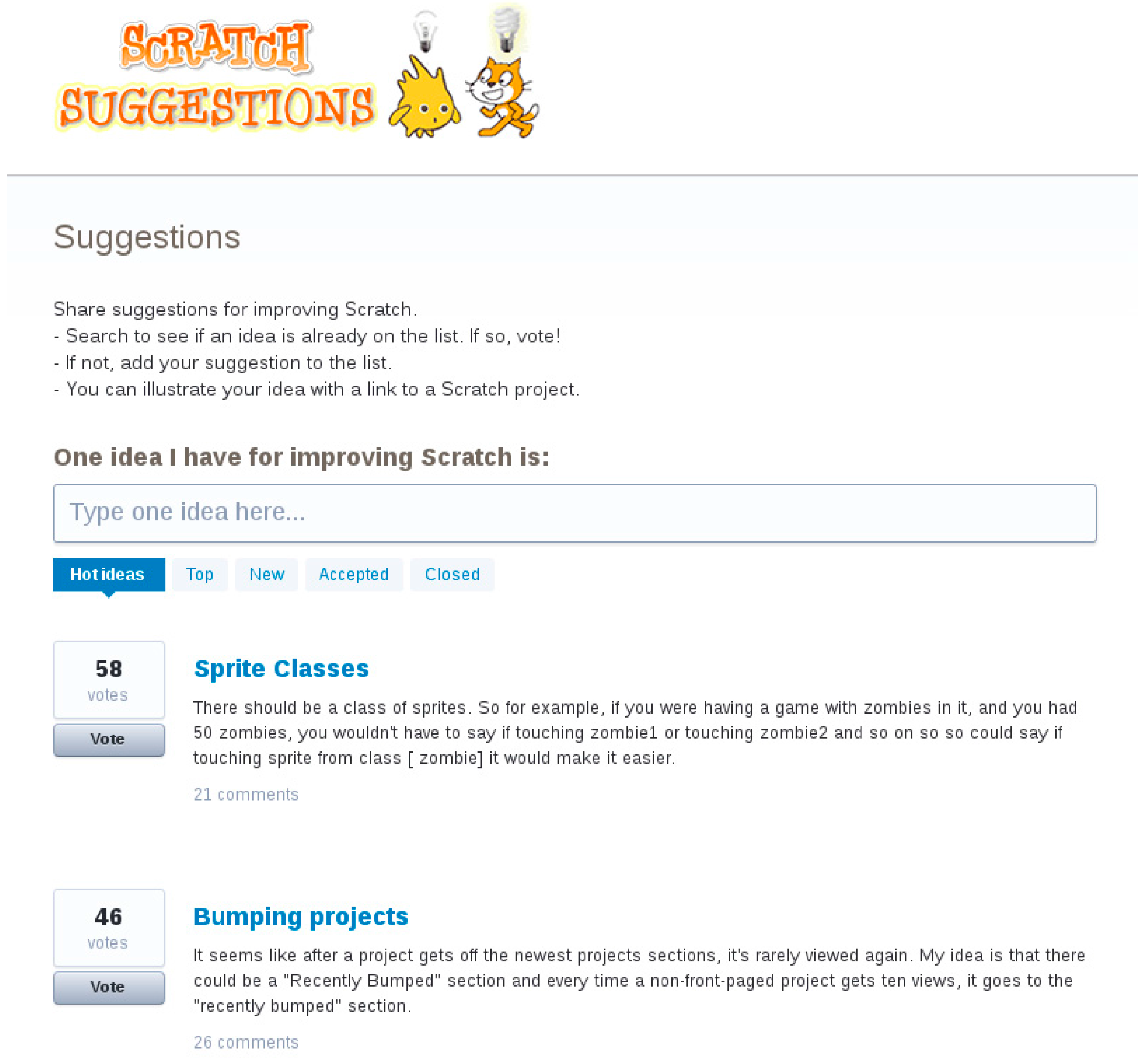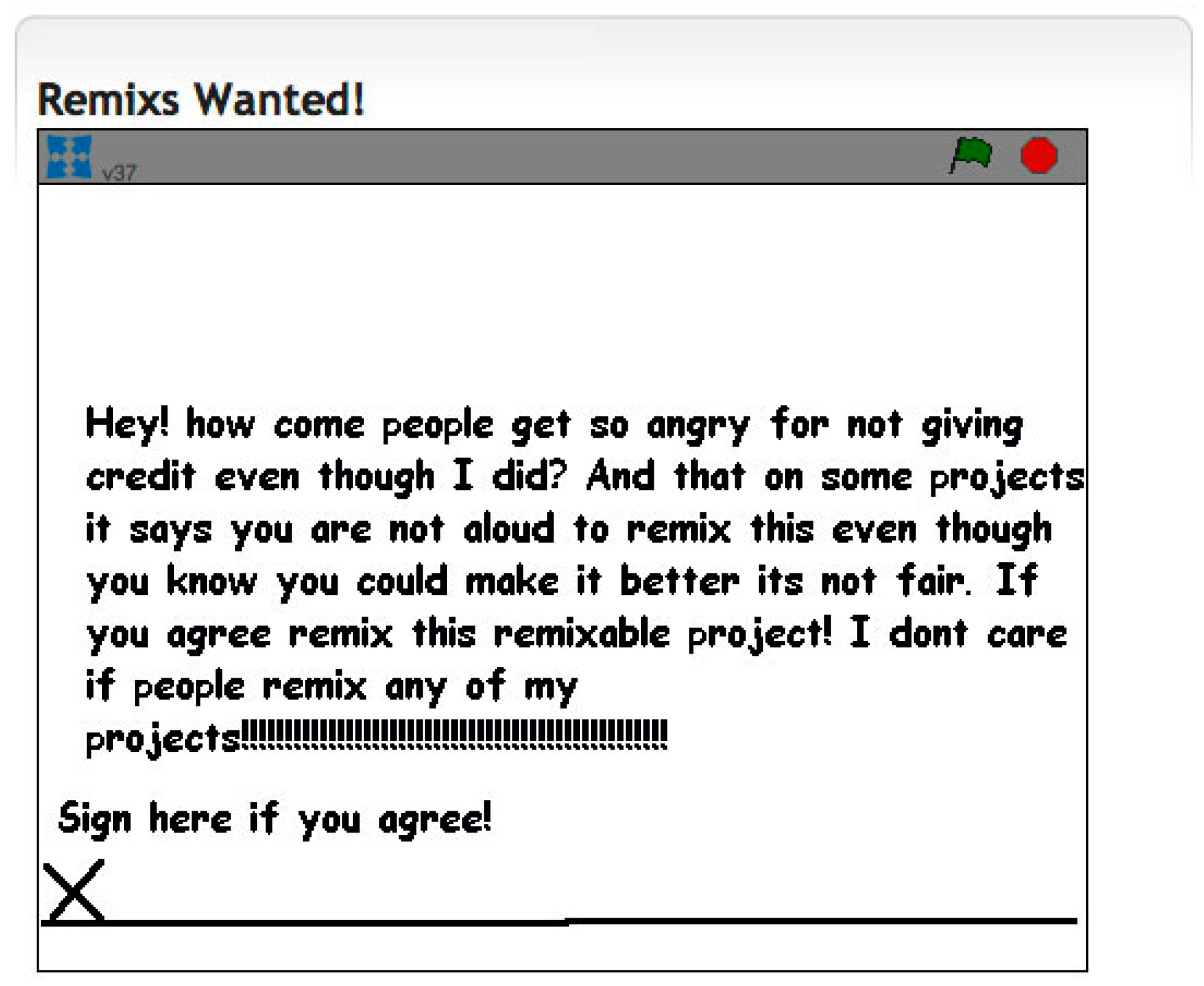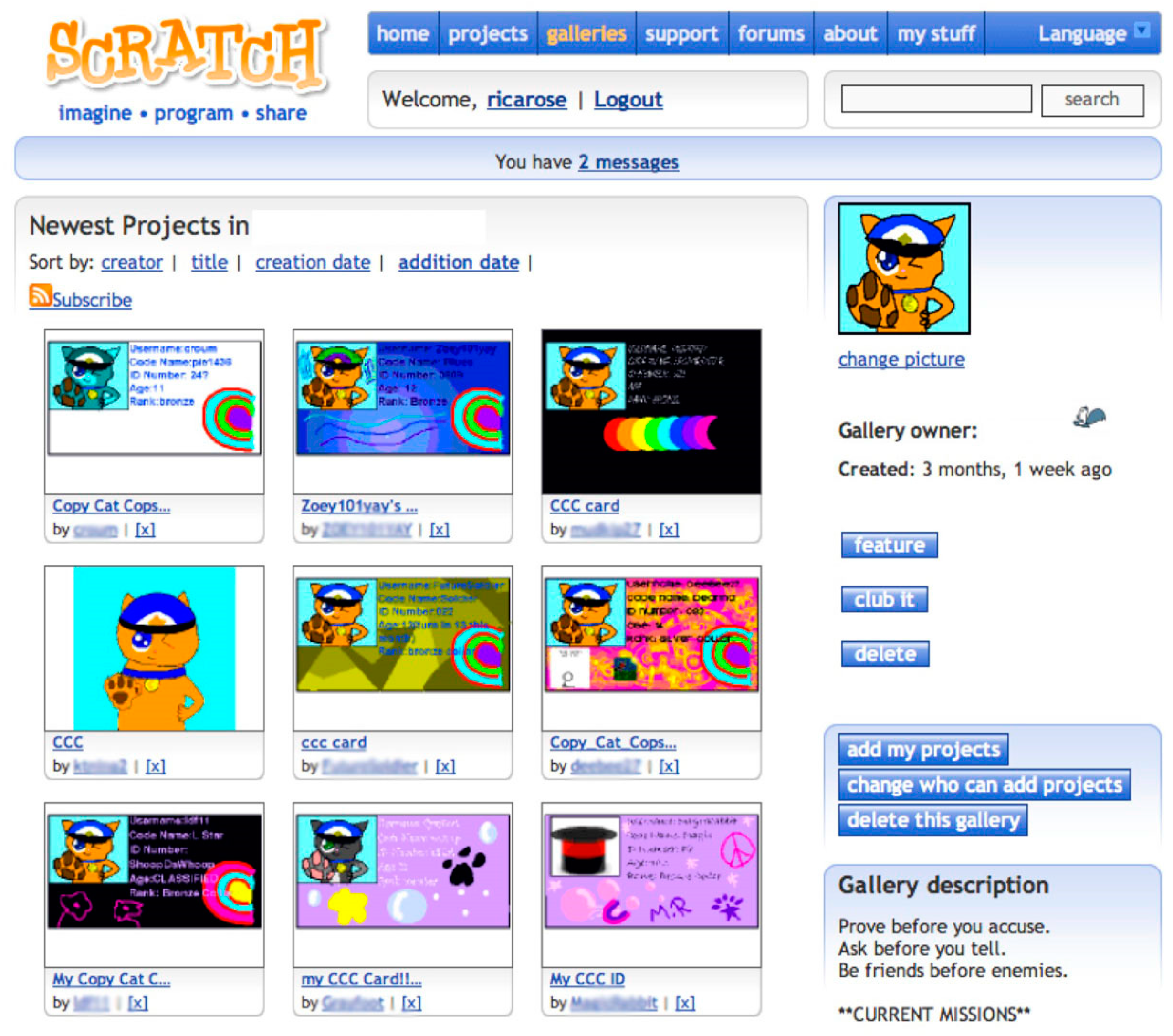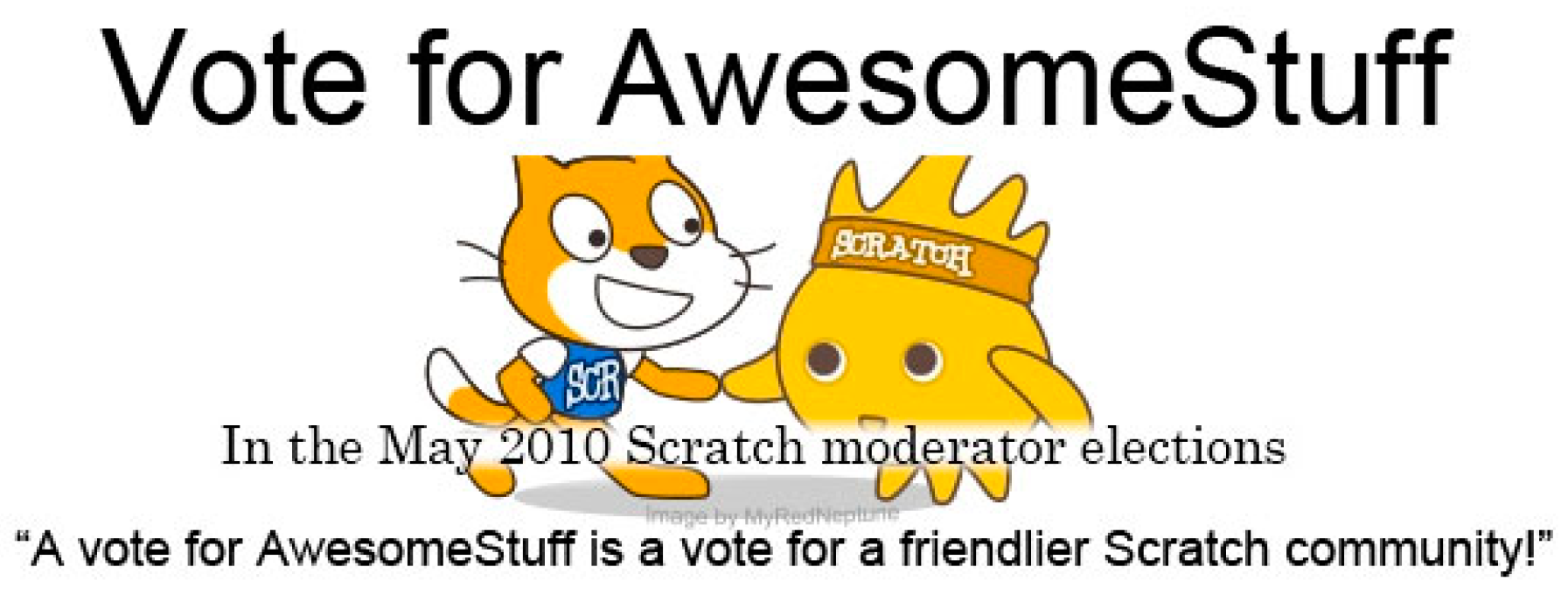1. Introduction
A young girl learns about animal testing from her favorite TV show. To express her shock about the way that animals are being treated, and to raise awareness, she creates an interactive media project and shares it in a large online community of other young creators. In her project, she includes graphic photos of animal testing laboratories to show how horrific it can be. Some children love her project, but others have strong negative feelings about the use of such graphic images. A debate ensues in the comments section of the project between the two groups, and soon, the moderators intervene. While the moderators appreciate the goals of the project creator, they worry that the graphic images may upset younger members of the community. As a compromise, the moderators decide to label it as “not for everyone,” which makes it less prominent on the website and harder to find, rather than censoring the project all together.
This vignette, drawn from our own experience, provides an entry point to the key themes we will develop in this paper: youth agency and civic engagement in online communities. A growing number of young people across the United States (and around the world) spend increasing amounts of time online. There, they engage in a wide variety of activities, from information search, to social media use, to participation in virtual worlds. According to a 2015 report by the Pew Research Center’s Internet and American Life Project, 92% of American teenagers report going online daily [
1]. However, in spite of widespread use, teen computing experiences vary widely, as does relative freedom of access (for example, access from home vs. from a public library) and form of participation (for example, watching videos vs. creating videos) [
2]. Children’s participation online is giving rise to, among other things, new forms of civic engagement. Henry Jenkins describes the emergence of “participatory culture,” which he defines as cultural forms “with relatively low barriers to artistic expression and civic engagement, strong support for creating and sharing one’s creations, and some type of informal mentorship” ([
3], p. 3). Members of participatory cultures feel strong social connections with other members, and feel that their contributions matter.Online platforms have become key spaces for civic action, and there is a growing body of scholarship that attempts to characterize the evolving nature of digitally-mediated youth activism. danah boyd [
4] has extensively documented the ways that teens use social network sites as “digital publics” in an age of increasingly privatized public space; boyd ultimately argues for approaches that privilege youth agency over those that attempt to overly control and regulate youth voices online. Jenkins et al. [
5] examine a wide range of youth-led social movements, from immigrant rights to fan activists, and find that young people take action across platforms, amplifying their voices “by any media necessary.” Bennett, Wells, and Freelon [
6] describe an
actualizing model to capture emergent youth-driven civic practices, in contrast to
dutiful models of citizenship that connect to more traditional forms of civic action. In the
actualizing model, people participate through social technologies that enable individual expression, and prefer loosely connected peer networks for information and engagement. Citizens under the actualizing model feel a diminished sense of duty, but a higher sense of individual purpose. By contrast, in the
dutiful model, people engage in their communities through formal political organizations or parties, and remain informed about their communities through the news. Overall, citizens under the dutiful model feel a strong sense of duty to participate in civic life.
In their analysis of 90 websites created by political and community organizations attempting to engage young people, Bennett and colleagues [
6] found that these online spaces primarily replicated traditional, dutiful models online, without connecting to the more actualizing practices of young people. They argue that these spaces must bridge the two models of citizenship, since in the actualizing model, there is a danger that individual action becomes delinked from broader community concerns, while in the dutiful model, there is a danger of too much distance from emergent youth practices. However, they argue, by creating bridges between the two models, systems designers can engage youth in ways that are aligned closely with their existing practices, and connect them to dutiful forms of citizenship (such as voting and news consumption) that remain important components of civic engagement.
In addition, Bennett [
5] explains the weaknesses of today’s civic education, which, if offered at all, has remained primarily textbook based—a medium far removed from digital technologies and online communities. According to Bennett, the curriculum is often “stripped of independent opportunities for young people to embrace and communicate about politics on their own terms” ([
5], p. 7). To address this shortcoming, he argues that civic education should accommodate youth practices and spaces. He also invites educators and other stakeholders to rethink “politics and the political” as youth continue to push the boundaries of participation with digital and social technologies [
5]. While there have been online digital media environments designed for youth civic engagement, Bennett et al. [
6] argue that their goals are often too narrow, and the structure too top-down, for broad, independent forms of engagement. Instead, they urge designers, educators, and others who interact with youth to focus their efforts on sites that young people already participate in and that offer creative and social spaces for engagement, such as Facebook and YouTube.
In this paper, we explore the forms of civic engagement that can occur in creative and social online spaces, focusing specifically at the Scratch Online Community. We define
civic engagement as working to improve one’s community [
7]. Members of the Scratch Online Community work to improve their community in a variety of ways, depending on how they appropriate the site’s functionalities. We focus on three research questions:
How do children engage in civic discourse and expression with their peers within the Scratch Online Community?
How do such expressions affect this community?
What lessons can we distill for educators and designers who want to encourage children to engage in civic life, rather than dissuade them?
2. Research Setting
Launched in 2007, the Scratch Online Community (see
Figure 1a) enables children, primarily between the ages of 8 and 16, to share interactive media such as games, stories, and animations created with the Scratch programming environment (see
Figure 1b) [
8]. As of September 2016, Scratch members had shared more than 16.3 million projects, and had exchanged over 87.4 million project comments.
1 Apart from uploading projects and commenting on them, members of the Scratch Online Community can also build upon, or
remix, each other’s projects. Members can download another member’s project, modify it, and share it again on the Scratch website as a remix. Community members can also collect and curate projects in a “project gallery” page, and participate in community-wide discussions through an online forum. Like other content sharing sites with social networking features, these creative and discursive spaces have emerged as “digital publics” [
4] where youth connect, discuss, and mobilize. What is interesting about the Scratch Online Community in the context of broader conversations about social media and political mobilization is the very young age of the Scratch population: primarily ages 8–16. A majority of the members of the community are well below the legal voting age, and many are preteens.
The Scratch Team at MIT designed and continues to maintain the website. A subset of the Scratch Team moderates the online community, answers questions, responds to reported content, and explains community values to members. In general, the Scratch Team moderators work closely with the site members to maintain a friendly and respectful environment. The Scratch Online Community Guidelines
2 articulate how members can also help maintain this environment, from offering constructive feedback to giving credit.
3. Case Study Selection and Analysis
To address our research questions, we developed qualitative case studies of a several acts of civic engagement in the Scratch Online Community. Case studies enable us to deeply explore a particular act and its development over time. We have been involved in the design and support of the Scratch community for more than two years, and have facilitated numerous user workshops and conducted several studies of community dynamics. Throughout this time, we have noted a number of civic acts within the community; we drew on this steadily growing archive of examples for case studies. We ourselves, as researchers, did not intervene in these activities; nor did we engage with the concerned members—however, in some cases, the moderation team (with whom we interact) intervened. We describe these actions by the moderation team in the relevant case studies that follow. We also interviewed the Scratch Community Coordinator, who oversees the moderation of the Scratch Online Community, to gather additional insight and suggestions for case studies.
We were aware of the fact that our work was potentially ethically sensitive, given that children were involved. Our research protocol was approved by our Institutional Review Board (IRB), and we took additional steps to ensure the anonymity of our research participants, to the fullest extent possible. All the content that we describe and analyze in this paper is public, and anyone with access to the Internet can potentially access it. In such a scenario, to ensure that the subjects of our case studies are not trivially traceable (through, for instance, a simple Google search), we slightly altered (without substantively changing) the text of any content that we reproduced verbatim. Additionally, we blurred all usernames in our screenshots. Finally, in line with the protocol submitted to our IRB, we changed usernames when we referred to specific members.
We sought case studies of various civic engagement activities from the two years between Fall 2010 and Spring 2012, and analyzed them for answers to the following questions: (1) What motivated Scratch members to act in the community? (2) How did they leverage the features of the Scratch website for their goals? (3) How did the rest of the Scratch Online Community respond to their actions? (4) How did the Scratch Team intervene or respond to the civic actions? We selected five case studies to demonstrate a wide range of civic activity that occurred on the site during this time period. We studied each event closely, and documented comments, projects, galleries, and other artifacts created by participating Scratch members. We also collected any relevant Scratch Team moderation notifications to Scratch members, as well as Scratch Team emails or meeting notes about these events. We used open coding to identify motivations, website uses, community reactions, and Scratch Team interactions. As we developed the five case studies, we conducted a cross-case analysis to explore similarities and differences in the data.
4. Results: Case Studies of Civic Engagement
We found a wide range of approaches to civic action in the Scratch Online Community. For example, our first two case studies, about the Japanese earthquake and animal testing, focus on issues in the world at large, while the remaining three case studies involve Scratch members trying to improve the Scratch Online Community itself. We explored civic practices that reveal young Scratch members’ desires toraise awareness, to encourage particular actions, and to participate in community governance. In each case study, we describe how Scratch members expressed themselves and engaged with their peers, and how the community reacted as a result.
4.1. Connecting in a Time of Crisis
When a 9.0 scale earthquake just off the coast of Japan devastated the country [
10], members of the Scratch Online Community responded by creating and sharing projects. These ranged from those that expressed sadness and shock, to those trying to spread optimism and hope. A Scratch member from Japan created a project gallery and added over a hundred projects created by other Scratch members, as shown in
Figure 2:
In addition to creating original projects in response to the earthquake, another member called on her friends to remix her Scratch project, and to sign her “petition” to spread hope for the people of Japan. She hoped that with enough signatures and Scratch members remixing her project, her project could raise awareness about how devastating the earthquake was.
Figure 3a shows her original project and the petition that asked for Scratch members’ signatures. As her friends remixed her project, other members began to notice and remix as well.
Figure 3b shows a screenshot from a remix by another Scratch member, and
Figure 3c shows the resulting remix tree, with her project in the middle and links pointing to other remixed projects. Each node in the tree represents a project, and every time a project in that tree is remixed, a directed link connects the original to the remix:
Soon, her project became the top remixed project that week, and appeared on the Scratch website homepage, a central page that is highly visible to all Scratch users. Once it was on the homepage, the rest of the community was able to see her project.
Figure 4 shows her project on the homepage, alongside other popular projects created in support of Japan:
The project comments also became a medium through which Scratch members tried to make sense of the disaster. Some members first learned about the disaster through these Scratch projects, and posted project comments to ask for more information. Other members shared what they were doing in real-life to support relief efforts, from making family donations to participating in community fundraisers. Still others tried to encourage members to go beyond making and remixing projects and commenting, and to donate to various relief organizations such as the Red Cross.
As the number of projects continued to grow, Scratch Team moderators decided to feature the gallery on the Scratch homepage (see
Figure 4). These projects and the gallery, along with the discussions they produced, became vehicles for members to connect during this crisis. They also became a way for members, especially those interested in Japanese culture, to collectively make sense of a disaster that affected the entire country and reverberated transnationally. This example highlights how Scratch members use the site’s creative features to build digital publics with their peers, and connect over issues they feel strongly about.
In this case study, we see an example of how children in an online social community, through their own agency, engage with a significant and tragic event in the wider world. Through this process of engagement, they raise awareness about the event and amplify their message by appropriating and utilizing the affordances provided by the technical system that powers the social community. They also produce discourse with their peers, collectively make sense of what has happened, and identify how they can help.
4.2. Raising Awareness of Injustices
Scratch members often create projects to protest against practices and policies that they disagree with, or consider to be unfair, such as animal testing. In addition to creating projects, Scratch members also amplify their messages by inviting their peers to remix their projects. For example, one project started off with the message
“Animal testing, the truth uncovered: Please read on to know what animal testing really is and why it is really unnecessary.” Then, the project displayed a set of graphic, gory images of animals being used for testing. One of the images showed a picture of a rabbit with parts of its skin removed, revealing its ribs and flesh (
Figure 5). The project ended with a longer explanation of why animal testing is wrong, immoral, and inappropriate:
For the moderators of the site, dealing with this type of project is challenging. As the Scratch Community Coordinator we interviewed put it:
“On one hand, we want Scratch to be a way for kids to protest things in their world that they think are objectionable or otherwise wrong, and so we want to encourage that sort of activism on Scratch. We like that it is a medium that can be used in that way. On the other hand, we have certain standards that we have to maintain because the site is viewed by kids who are often very young, and we don’t think it’s appropriate to show images of animals that have limbs missing or are being vivisected in various ways.We don’t think kids [as young as 7 or 8] have the level of maturity that it takes to understand the issue—more likely, they would be traumatized.”
.
For most projects with graphic images, the general reaction from the moderation team is to remove them, and send the creator a notification message that articulates these concerns. A sample notification message:
“We support your right to speak out about important issues like animal testing. However, we felt the images used in your recent project were too violent and scary for younger Scratchers. (Keep in mind that the Scratch website is viewed by children as young as 5 years old.) Please feel free to share projects about this issue that do not contain violent images. Use the contact us link to discuss this if you have any questions. Scratch On!—Scratch Team.”
.
In this notification, the moderation team tried to clarify that there is nothing wrong with expressing an opinion about an issue, but there are limits on what is appropriate for a website that is visited by a very young age demographic.
Reactions to these notifications varied. Sometimes authors pushed back, especially those who were emotionally attached to these issues. One author complained to the Scratch Team, saying that censoring such projects was unfair and that she should not be stopped. In other cases, the authors re-uploaded newer versions of the project, with some of the graphic elements removed.
From the perspective of the community, reactions varied as well. Some members supported the removal of what they saw as imagery that was too graphic for the Scratch website, while others disagreed. In general, there was overwhelming support for the message of such projects—with comments like: “
That’s so wrong!!!!!!!!!!! I’m remixing!” As with the previous case study, some members also shared information about what they were doing in the offline world about the issue, with comments like: “
Me and my friend sold lemonade and earned $150 in a day, and donated it to a place that’s fighting animal cruelty!” Others, however, expressed concern that they might get banned for remixing the project because of the graphic content’s possible inappropriateness (“
[...] I would remix, but I might get flagged and banned...”) [
13]. In one case, a parent contacted the Scratch Team, describing how her child became deeply upset after seeing a graphic animal testing project.
Raising awareness and rallying support against animal testing is another example of how Scratch members use the medium of Scratch projects, comments, and forum discussions to highlight injustices they feel strongly about. Pippa Norris describes this category of activism as “cause-oriented”, where activists “pursue specific issues and policy concerns among diverse targets, both within and also well beyond the electoral arena” ([
14], p. 4). For many of these projects and discussions, moderators (and members) have to walk a thin line between freedom of expression and ensuring a safe environment for Scratch members of all ages.
4.3. Lobbying for Community Improvements
Members of the Scratch Team manage the design of the Scratch programming language and its online community, and part of this work is to generate and discuss new ideas to enhance or extend Scratch, which may become implemented as new features. We found many examples of Scratch community members sharing their own ideas and arguments for community improvements, using a variety of practices to lobby for changes in how the online community functions. Their lobbying practices varied considerably, ranging from emails to the Scratch Team to forum threads that demonstrate community mobilization.
In some cases, Scratch members created and remixed Scratch projects to help illustrate their points, especially for “feature requests” for the Scratch website. These projects typically consisted of elaborate mock-ups of interface and interaction designs, demonstrating how the new feature might look and function.
Figure 6 shows a Scratch project that is an interactive mock-up illustrating a design for an improved and customizable Scratch member page:
To explicitly support this kind of engagement, and to have a dedicated space for discussing ideas, the Scratch Team launched an additional website in 2010 called Scratch Suggestions (see
Figure 7), where Scratch members could submit ideas and others could vote and comment. Soon, this site became one of the primary avenues for Scratch members to voice their demands. However, a significant amount of activity continued to take place on the main Scratch website, where members with suggestions campaign for votes for their ideas.
To demonstrate how young Scratch members use the platform’s affordances to lobby for community improvements, we chose an example of a suggestion to improve one of the most visible spaces in the community: the homepage. When a project appears on the Scratch homepage, it receives the attention of the entire community, building the reputation of the project author. As the community grew, Scratch members with multiple projects featured on the homepage became “celebrities” within the community. Many Scratch members considered this to be a disproportionate distribution of front-page “real estate,” and they demanded an increase in the number of visible projects on the homepage. For example, in late 2010, a Scratch member created a forum thread for other members to voice their opinions and discuss how to implement such a change. Over a year, the thread’s creator maintained it actively, engaged in discussions, and highlighted comments from others that she thought were important. She also created an entry in the suggestions website that linked to the forum thread.
Based on these discussions and community input, in late 2011 the Scratch Team changed the front page algorithm so that instead of showing only the top three projects in a given category at a given time, a random selection of three of the top ten projects was shown instead. Scratch members happily received this new implementation, especially since it was lobbied for by the community.
Most community-related lobbying actions by Scratch members evidence an interesting mix of peer-to-peer mobilization with targeted content production. Members try to explicitly target and engage the Scratch Team, but they also understand that to attract attention, they need to mobilize a large crowd. This works in a way that is very similar to grassroots political processes in offline spaces. Coleman [
14] describes the first form of engagement as happening through “horizontal channels”, where “networks and collective associations can be formed,” and the second as happening through “vertical channels,” which provide “dialogical links to various institutions that have power and authority” ([
15], p. 202).
The examples above show how children using a socio-technical system can also participate in and influence its design process, through a mix of grassroots peer mobilization and direct engagement with the institutional powers that determine the direction in which the system in question is going to evolve. However, having said that, this process is not without its pitfalls. For example, when responding to Scratch members, the Scratch Team finds it challenging to prioritize which suggestions to review, implement, or reject. Sometimes this prioritization can lead to tensions within the community, as the Scratch Team may disagree with a submitted suggestion. In other cases, a popular suggestion may go against a core value of the Scratch Team, leading members to express dissent in various forms, as in the debate around remixing that is described in the next case study.
4.4. Protesting Community Policy
Projects on the Scratch website are automatically shared under the Creative Commons Attribution-Share Alike License, which allows other members to share and remix these projects as long as they provide attribution and share their remix under the same license. Anyone with a registered account can download the source project, which gives access to the Scratch code and all media assets such as images and sounds. Many members find this to be a valuable feature, as it allows them to learn from others’ work. Besides looking at source code and exchanging assets through remixing, Scratch members also engage in social remixing activities such as chains and contests [
16]. However, this policy of open sharing and remixing has also been controversial in the community, since some members equate
remixing to
stealing. While the website supports automatic attribution when a project is remixed (see
Figure 8), studies suggest that this feature is not enough for members, and that manual credit given by the remixer is more valued [
17].
Some community members have protested this remixing policy, through creating projects or posting comments about the topic. Despite strong disapproval of remixing from some community members, the Scratch Team continues to uphold remixing in the Scratch community. In addition to maintaining the policy, the Scratch Team added a section on the homepage (the most visible page on the Scratch website) to show the top remixed projects, as a way to promote remixing. The Scratch Team also engages in discussion about remixing in project comments and forum discussions, where they often describe the value of building on top of the work of others and point to how Scratch members’ work already builds on the work of other creators. This engagement with the community also involves facilitating the efforts of Scratch members who do support remixing. For example, one member created a project “petition” to encourage other members to show their support, as shown in
Figure 9. A Scratch Team member remixed her project, which then amplified her petition even further:
While the Scratch Team does draw a line between remixes and exact copies, and notifies project creators of exact copies in order to promote giving credit to the appropriate Scratch members, these efforts are not enough for some. Scratch members have gathered together to form vigilante groups to identify and rally against “copiers” and “stealers.” One such group, called the Scratch Security Services (SSS) was founded by a 12 year old member; the group at the time of the study consisted of over 20 members. To communicate and coordinate, members appropriated a project gallery (as shown in
Figure 10) and used the gallery comments to discuss remixes and offenders. Members also created Scratch projects to come up with “Copy Cat Cop badges” to associate themselves with the SSS. Across the community, members examined remixes to determine if projects were copies before reporting the project to the Scratch Team. The group also helped members settle conflicts over projects, and asked members who copied projects to provide credit to the original creator. Other vigilante groups formed to attack members who were accused of copying. These groups flooded the accused project with aggressive comments, and even created Scratch projects to rally more members against “copiers.”
In response to vigilante groups, Scratch Team moderators intervened in ways that ranged from facilitation to account bans of vigilante members. For the Scratch Security Services, who practiced moderation in their efforts, with a motto to “prove before you accuse, ask before you tell [the Scratch Team],” Scratch Team moderators helped in their efforts to encourage creators to give credit appropriately. For the more aggressive groups who attacked members, moderators temporarily banned the accounts until the attacker apologized and recognized that their actions violated community rules. Banned accounts lost access to their account privileges, such as uploading projects and leaving comments, essentially losing all social connection to the online community.
Remixing continues to be a feature of the Scratch website. However, it also continues to be a contentious issue, and members have strong and divergent feelings about remixing and ownership. This case study illustrates how young Scratch members are willing to defy community policies to voice their opinions, and at times even to risk their own account access to act according to their beliefs. The “vigilante” groups also highlight how members can self-organize within the website to form their own counterpublics [
18]. In the project galleries, members can develop their own group identity, space for discourse, and organizational structure to mobilize and take collective action.
4.5. Participating in Community Governance
While Scratch Team members moderate the community, Scratch members can also join the moderation team by becoming Community Moderators. Other online communities such as Wikipedia have set up both formal [
19] and informal [
20] means for members to participate in policy decisions and community governance. Such forms of engagement promote not only a healthier community, but also deeper participation among members. Community Moderators answer questions, give feedback, help explain community values, and clean up the forums by removing off-topic posts or inappropriate content.
The Community Moderator program initially began as a way to promote Scratch members who were actively involved in helping the community by answering questions about Scratch, directing members to useful resources on the website, and reporting inappropriate content and behavior to the Scratch Team. A private discussion forum was created for moderators to discuss issues, especially how to address complex community topics. Moderators now regularly use this private forum to discuss issues with other moderators and Scratch Team members. Because community moderators are also active Scratch participants, they have perspectives that Scratch Team members may not have. These discussions then inform actions and policies for broader implementation.
Originally, Community Moderators were hand-picked by the Scratch Team. However, as the role continued to evolve, the Scratch Team decided to implement community elections. Scratch members can nominate themselves to become Moderators. The Scratch Team then picks from the pool of nominees to determine a final set of candidates that the community votes on. The Scratch member with the most votes becomes a member of the moderation team. The Moderator elections have become a community event, especially in the website discussion forums, where most of the election occurs. Nominees post long messages in the forums to explain why they want to become Moderators. Some nominees create their own web pages or media to campaign and gain support from community members.
Figure 11 shows a sample image created by a Scratch member to promote his community moderator nomination:
Recently, Scratch Team members have discussed expanding the role of community moderators beyond the website discussion forums and into the larger online community. For example, a recent initiative led by the Scratch Community Coordinator in collaboration with a community moderator aims to create a “Welcoming Committee” of Scratch members to connect with new members and help them get situated in the rapidly growing Scratch Online Community.
Since its inception in 2008, and with the subsequent implementation of elections, the community moderator role has become a way for members to become more deeply involved in the online community, in a way that is more formally structured than the case studies described earlier. Through this participatory governance mechanism, the Scratch Team and the community moderators have created a way for members to take on more responsibility, and to develop a greater sense of community ownership as they work together to maintain a respectful and friendly online space.
5. Discussion
The Scratch website was not specifically designed to encourage children to participate in civic action. It was targeted towards members of a young demographic who wanted to easily share creations that were personally meaningful to them with other creators from all over the world. This design was influenced by Seymour Papert’s concept of Constructionism [
21], where Papert argues that learning happens best when people are actively building things that are personally relevant to them, especially when they are building with or for others [
22]. When members do decide to participate in civic engagement within the Scratch community, they do so on their own terms, creatively using the features and affordances of the Scratch platform.
As we investigated our research questions, we found Scratch members creatively expressing issues that were meaningful to them, and engaging with other members of the community around these issues in various ways. Together with these forms of expression and engagement, we also saw that the reaction from the community spanned from amplifying a Scratch member’s message by remixing and promoting to the front page, to the Scratch Team intervening when such actions violated community guidelines. We summarize these case studies across the forms of
expression,
engagement, and
reactions from the community in
Table 1.
Each of these case studies showcase individualized forms of civic engagement, with young people expressing their beliefs and engaging in civic action on their own terms. Under Bennett’s actualizing vs. dutiful citizenship model, where actualizing supports personalized citizenship and dutiful supports more traditional forms of engagement, all of these case studies can be considered examples of actualizing citizenship. However, instances of dutiful forms of citizenship can be seen across these case studies as well, especially in those where members are engaged in internal Scratch community issues. In the case of “lobbying for community improvements,” members vote and campaign across the community to educate and gain support for their suggestions. In protesting remixing policies, members form their own counterpublics and encourage their peers to join. These efforts illustrate the strong sense of duty that some Scratch members have when they participate in this community.
While instances of actualizing citizenship in the community tend to emerge organically, actions more aligned with the dutiful citizenship model were explicitly supported by the Scratch Team, either in the form of the affordances of the tools available to community members (the Scratch Suggestions website), or through active scaffolding of dutiful activities (community moderator elections). As a caveat, it should be noted here that even if explicit structures, affordances and support are not available, there is a significant tendency for members of the community to appropriate existing system components and use them to fulfill their own purposes. For example, while the Scratch Team created the Scratch Suggestions website, members continued to use the website discussion forums and email to lobby the Scratch Team for change.
In answering our third research question, “What lessons can we distill from these narratives for educators and designers to engage children in civic life?” we reflected on the two problems presented by Bennett: the declining relevance of civic education, and how to bridge between actualizing and dutiful citizenship models. In light of the five case studies, we provide the following recommendations for designers and educators interested in enhancing their environments and learning experiences to engage youth in civic life.
5.1. Connect to Where the Learners Are and What They Are Already Doing
Bennett argues that civic education needs to connect with the emerging creative and social practices of young people. Unfortunately, much of civic education today has tended to be far from the “digital publics” that young people have created for themselves. Instead, civic education tends to be textbook-based and regimented. As these case studies illustrate, Scratch members express their views on issues that are personally meaningful to them and share these expressions through their social connections. By encouraging young people to connect to personally meaningful topics, and by enabling them to express their opinions and actions through tools and practices that they are comfortable with, designers and educators can create an environment that is conducive to civic engagement.
5.2. Facilitate Rather than Dictate
In a study of online youth engagement projects in Britain, Coleman developed two models to describe the ways in which organizations foster youth citizenship. In a managed model, youth are seen as citizens to be trained and cultivated to participate in traditional forms of engagement. By contrast, in an autonomous model, youth are seen as citizens to be empowered and encouraged. In our case studies, the Scratch Team can be seen as an organization that manages the website, but does not dictate the expressions and forms of engagement that young people can create and participate in. However, the Scratch community is not a completely autonomous model, since members must observe the community guidelines or face account bans. In the “protesting community policies” case study, a number of vigilante groups formed to prevent the copying of Scratch projects. Some vigilante groups targeted and verbally attacked members they thought were ‘stealing.’ Because being respectful is a community guideline, the Scratch Team responded by banning the members of these vigilante groups. However, other vigilante groups formed that reported potential project copies to the Scratch Team to take care of, rather than taking it upon themselves to act against other members. In response, the Scratch Team engaged with these groups to facilitate their collective efforts, rather than to shut them down. It is not enough to adopt one model or the other to support youth citizenship; instead, it is key to develop a model where youth efforts are facilitated rather than either dictated or ignored.
5.3. Encourage a Sense of Ownership over the Community
Citizens whose practices fall under the dutiful model have a strong sense of civic obligation to engagement in their communities. While the case studies all illustrate members pursuing issues and activities that are personally meaningful to them, there are also examples of dutiful engagement, particularly in the case studies that revolve around Scratch community related topics. In these cases, we found that the Scratch members had a sense of ownership over the community. Being able to influence, even in part, the community’s governance mechanisms and infrastructure leads to more engaged and genuine civic action. This can be established both by policy (encouraging feedback and input from members), and by design (affordances for suggestions and ideas). The community governance model can also be modified so that members can participate in roles with increased responsibility and influence (elections for moderators).
5.4. Support Channels for Dutiful Citizenship
Explicit channels for dutiful citizenship are useful to scaffold traditional civic engagement processes, such as voting. On the other hand, systems that support actualizing citizenship by enabling individual expression can foster more personalized civic engagement. These spaces of personal expression can also be opportunities to connect young people to dutiful practices. In the case study of lobbying for community improvements, members who had ideas for the Scratch Online Community could share their idea on the Suggestions website and have a digital space specifically carved out for other members to discuss and vote on their suggestion. Seeing other ideas within the Suggestions website can also be an encouraging experience for members to voice their opinions. Having structures in place for members to engage in traditional civic practices, while supporting their engagement in personally relevant topics, can help bridge the two citizenship models.
6. Conclusions
At the time we began this research project, the world was commemorating the tenth year since the September 11 attacks on the United States. Echoes of this commemoration could be seen on the Scratch Online Community as well, with projects, forum threads, and comments expressing support and empathy for those who had been affected by the events. Given that the average age of a Scratch member is 13, many of the discussants were very young, some not even born yet, when the attacks took place. In addition to expressing recognition of the anniversary, Scratch members took this as an opportunity to make sense of the events, explore personal feelings, and share stories they had heard from family and friends. These interactions in the Scratch community, like the five case studies we described above, highlight how this creative and social platform enables children, many otherwise too young to participate in traditional forms of civic action, to express themselves and engage in the wider world they are growing up in. In addition, their civic practices, from debate, to protesting, to community electoral politics, to collective action, showcase how this medium for personal expression and social connection can be a critical space to support forms of actualizing and dutiful citizenship. For a young audience whose views of citizenship and engagement are just taking shape, Scratch Online provides opportunities to take action, to connect, and to impact their communities through civic practices that may be otherwise unavailable to them.
Designers and educators can learn from the experiences and practices that young people are crafting for themselves when they engage in their online and real-life communities. Instead of dictating the topics for discussion and the ways in which young people engage with those topics, designers can encourage youth to connect with personally relevant issues and facilitate multiple forms of expression and engagement. Finally, to help connect these personal and individualized forms of engagement (actualizing citizenship) to more traditional forms (dutiful citizenship), designers and educators can help foster a sense of community ownership. By supporting channels for dutiful citizenship by way of policy, design decisions, or changing governance models, designers can create channels that foster dutiful citizenship while connecting with youth interests. As young people leverage the affordances of digital media to push the boundaries of civic engagement, it is imperative that designers and educators keep up with, and respond to, these new and evolving forms of youth-generated digital expression and action.
